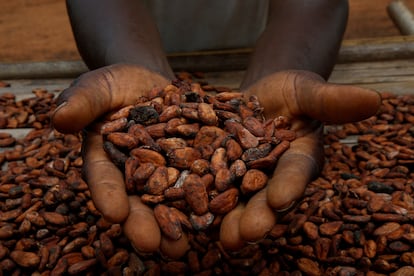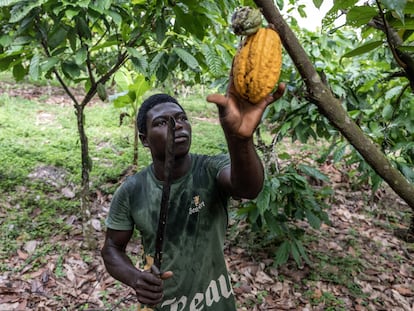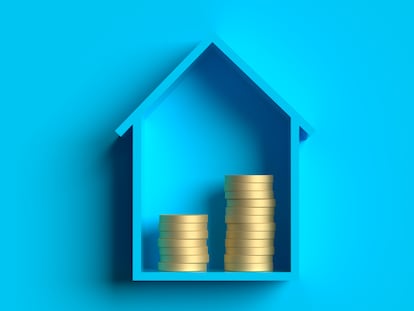Between gold fever and cacao fever
It may be premature to talk about a rally of the metal, but we’re late in talking about the bean’s: by Easter, cacao’s price per ton had risen above $10,000, an all-time high

It may be premature to talk about gold fever, but it is striking that, during the opening minutes of the first session in the second trimester, its price by the ounce had nearly a 2% revaluation.
My prognosis for this year was for a dramatic revaluation of the gold ounce, which has already come to pass with this year’s rise of nearly 10%. I think that at the height of 2024, that rise will hit 30%.
But even more striking is the fact that this rise in the price of the ounce of gold has been compatible with the appreciation of the dollar against the euro, which, since the beginning of 2022, has been 5%, meaning that those who had invested in gold at the time (and who had the euro as their financing currency) have accumulated a 28% revaluation of their investment, of which 23% corresponds to a rise in the price of gold and 5% to the appreciation of the dollar against the euro.
For the most part, it is normal for dollar and gold prices to move in opposite directions (i.e., when the price of gold rises, the price of the dollar falls), but there are always exceptional periods during which both appreciate or depreciate. And it seems that we are in one of those moments in which both appreciate or, at least, the rise in the price of gold is much higher than the depreciation of the dollar. Such has been the case for the last month and a half. While the price of an ounce of gold has risen by 13%, the dollar has depreciated by only 0.6%.
All signs are pointing, therefore, to gold investment as a winning bet this year, though I have no convincing explanation as to why that is.
Some argue that the central banks of non-aligned countries (meaning, those aligned with Russia) have been buying gold and avoiding the dollar as a way of accumulating reserves, in view of the sanctions that the United States and its Western allies, plus Japan, have imposed on Russia after its invasion of Ukraine, most notably via the freezing of its assets in Western banks.
That’s a reasonable explanation, but between the reasonable and real there is often great distance. Among possible counter-arguments is the fact that, despite the invasion of Ukraine having begun in February 2022, the price of gold not only did not have a strong immediate upward reaction, but between February and November of that year, it fell by 21%. In other words, either the actions of the central banks were delayed, with them taking nine months to contemplate, or other factors were at play that had nothing to do with what the central banks were doing and which, at any rate, cancelled out the effect of the central banks’ purchases, if significant amounts of them had been made at all.
At some points in time, the rise in the price of gold has been explained by the fall in real long-term interest rates on the dollar. But this time, since the beginning of 2022, the real yield on 10-year U.S. government bonds has gone from -6% to +1%, while gold has appreciated by the previously mentioned 23%.
As on other occasions and for practically any market, there is no good explanation that can be generalized to serve in all moments and places and that an abundance of counterexamples don’t end up destroying.
It may be premature to talk about gold fever, but we are already late in talking about cocoa fever: during Easter week, the bean’s price per ton exceeded $10,000, which represents an absolute historical high point for a price series that dates back to 1971. In fact, already last December, the price of cocoa surpassed the previous historical high point, which had taken place in 1977. This vertical rise in price has resulted in a cumulative appreciation since September 2022 of 372%.
In this case, there is a reasonable ad hoc explanation (bad harvests over several years), as is usually the case with other phenomena, but nobody or almost nobody has applied it in a preventative manner (and even less in such an extreme manner) as to predict such a rise.
The fact that the price of cocoa has been depressed for 42 years seemed a good basis for betting on its exceptional rise, but those who tried that tactic in years past have seen their bet end in huge losses.
That is what happened in 2010 to a cacao trader nicknamed “Chocfinger” due to his mysterious purchases — in other words, the Goldfinger of chocolate. His real name was Anthony Ward of Armajaro Holdings, and he is known for having made a massive purchase of 241,000 tons of cocoa worth $832 million that ended in disaster. We’ll probably see those same tears again in this market. They might not be too far away.
Juan Ignacio Crespo is a Spanish government statistician and financial analyst.
Sign up for our weekly newsletter to get more English-language news coverage from EL PAÍS USA Edition
Tu suscripción se está usando en otro dispositivo
¿Quieres añadir otro usuario a tu suscripción?
Si continúas leyendo en este dispositivo, no se podrá leer en el otro.
FlechaTu suscripción se está usando en otro dispositivo y solo puedes acceder a EL PAÍS desde un dispositivo a la vez.
Si quieres compartir tu cuenta, cambia tu suscripción a la modalidad Premium, así podrás añadir otro usuario. Cada uno accederá con su propia cuenta de email, lo que os permitirá personalizar vuestra experiencia en EL PAÍS.
¿Tienes una suscripción de empresa? Accede aquí para contratar más cuentas.
En el caso de no saber quién está usando tu cuenta, te recomendamos cambiar tu contraseña aquí.
Si decides continuar compartiendo tu cuenta, este mensaje se mostrará en tu dispositivo y en el de la otra persona que está usando tu cuenta de forma indefinida, afectando a tu experiencia de lectura. Puedes consultar aquí los términos y condiciones de la suscripción digital.
More information
Archived In
Últimas noticias
Most viewed
- Reinhard Genzel, Nobel laureate in physics: ‘One-minute videos will never give you the truth’
- Oona Chaplin: ‘I told James Cameron that I was living in a treehouse and starting a permaculture project with a friend’
- Pablo Escobar’s hippos: A serious environmental problem, 40 years on
- Why we lost the habit of sleeping in two segments and how that changed our sense of time
- The fall of a prolific science journal exposes the billion-dollar profits of scientific publishing











































